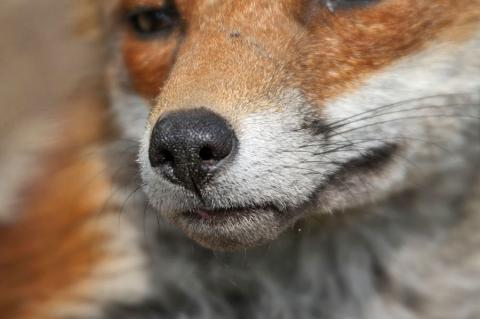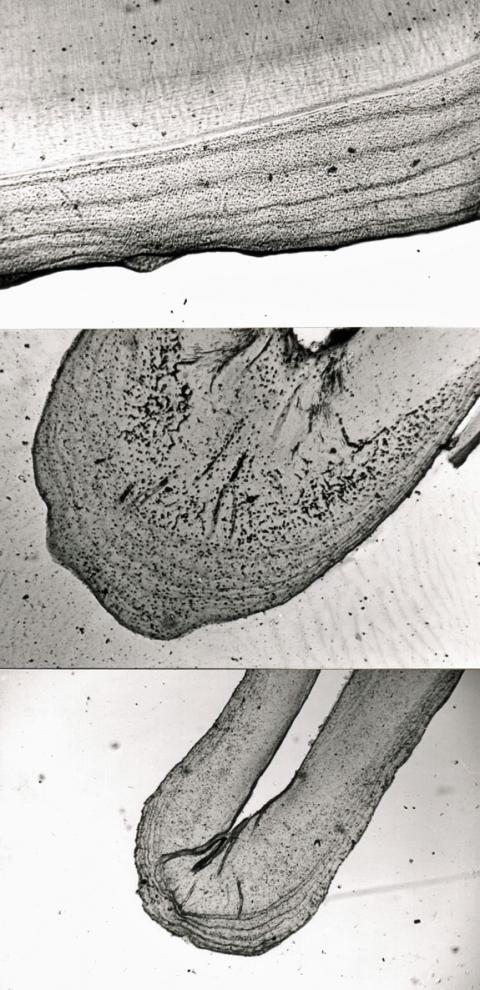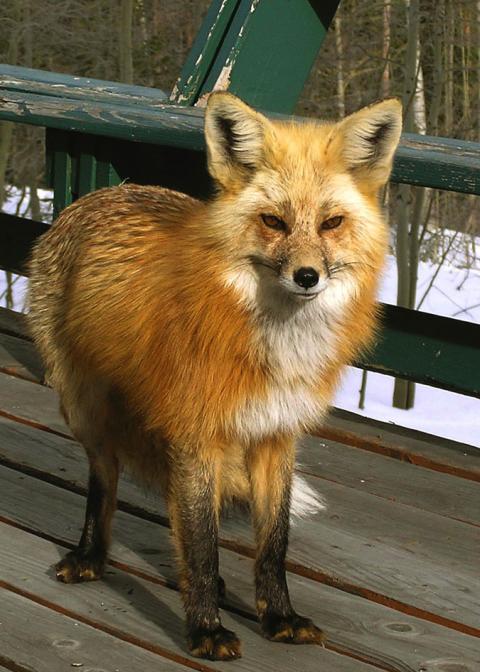Red Fox Longevity
Techniques for ageing foxes

Over the years, various methods have been used to try and estimate fox age, including the weight of the eye lens, general dental development (i.e. tooth eruption), tooth wear, baculum (penis bone) development, cranial measurements and tooth sectioning. In a 1978 paper to the Journal of Zoology, Bristol University biologist Stephen Harris (at the time based at Royal Holloway College in Surrey) compared the effectiveness of various different techniques on a sample of 336 foxes killed in London between 1971 and 1973.
Harris found that visual inspection of the baculum could separate juvenile and adult males (obviously of no use for females), but no separation of year classes was possible. Similarly, the weight of the eye lens -- which grows throughout life but experiences very little wear -- could separate yearlings from adults (91% with lenses weighing less than 210mg were less than a year old), but thereafter there was too much overlap between age classes to be reliable. Harris also found that tooth attrition (wear) could be used effectively in some populations (93% of the sample up to four years old were correctly aged this way), but was a highly variable character -- it's heavily related to the diet of the animal in question, and tooth wear is slower in old age -- and was thus not a reliable method of assessing absolute age. Overall, Harris concluded that:
"None of the measurements of growth (baculum weight, eye-lens weight, skull and skeletal measurements) proved of any absolute value for age determination in the present study ..."
Harris found that the most effective method of ageing foxes was to use incremental lines of cementum. Cementum is a bone-like connective tissue that covers the root of a tooth, providing protection, support and a connective surface for fibres that attach the tooth to the jaw bone; it's laid down throughout the animal's life with heavily mineralized layers (incremental bands) alternating with those less mineralized (incremental lines). The result is that, if you cut the tooth into sections and dye it, the tooth has a banded appearance, with incremental lines showing up as light strips.
Exactly why mammals deposit these light and dark bands is unknown, although there are several theories, including that lack of food and a harsh climate cause compacted (dark) layers of cementum to form (the "environmental effect"), and that they're associated with physiological changes during the breeding cycle (the "endogenous effect"). Either way, the idea is that you can count the tooth rings, like you would the rings of a tree, to determine its age. (Image: Three Red fox tooth cross-sections showing how staining highlights incremental bands, allowing an estimate of the animal's age. Photos courtesy of Dr Jonathan Reynolds at the Game and Wildlife Conservation Trust.)

In a study published in the Danish Review of Game Biology during 1968, Birger Hensen and Lise Nielsen were the first to establish counting cementum rings as a method for ageing foxes. Hensen and Nielsen's method involved soaking a fox canine and incisor in nitric acid (to remove the calcium) and cutting it into thin, 30 micron (i.e. about 330 slices to a centimetre or 847 to an inch), sections before staining it with a dye called Mayers Haemalun. The biologists established that the dark zones (incremental bands) were laid down during the autumn and winter and that, despite some problems discerning the bands (this apparently requires practice), the method offered "valuable possibilities for absolute age determination of Danish foxes".
In 1974, game biologist Stephen Allen used a slightly modified version of this technique to accurately age (i.e. correct to the nearest year) 95 foxes tagged as cubs in North Dakota and, in a 1993 paper to Gibier Faune Sauvage, Game Conservancy biologists H.N. Goddard and Jonathan Reynolds found that this method correctly aged six (66%) out of nine foxes of known age, was correct or over-estimated the age of 21 (91%) out of 23 foxes of known minimum age, and was one year below the known age in two animals. Goddard and Reynolds also found that the first dark line was deposited between January and March of the cubs' first year and suggested that both sexes are likely to be metabolically stressed during this period because, not only is this generally the coldest time of year, but it is also the breeding season.
More recently, Paul Simoens and colleagues at Ghent University in Belgium observed a good correlation between the age of a fox and the number of cementum growth rings; they found that domestic dogs were less accurately aged by this method and speculate this is because they no longer experience the seasonality that foxes are exposed to. Writing in a 2005 paper to Vlaams Diergeneeskundig Tijdschrift, Simoens and his colleagues raise an interesting question:
"It may be wondered whether the gradual urbanization of red foxes will influence their natural way of life in such a manner that the cementum growth line count will no longer be reliable for age determination in these animals."
So, sectioning and staining a tooth seems to be the most reliable way of estimating the age of a dead fox, while the degree of wear of the incisors can give a fairly accurate estimate of live animals. Some authors have suggested that canine teeth are best to section, while others have found better results with incisors -- in a recent (2007) paper to Folia Zoologica, however, Czech biologists Jana Roulichova and Milos Andera report that, although canines are best for the task, age can be estimated from any of the premolars. Whichever tooth type is chosen, it is often advisable to take multiple samples from the same animal. Harris, in his 1978 paper, found that:
"For an accurate assessment of an animal's age it is important to section more than one tooth because different teeth from the same animal may yield slightly different counts ... and so the determined age should be based on sections of at least two teeth."
Life expectancy in foxes
Perhaps unsurprisingly, the longevity record for a Red fox comes from captivity. In his 2005 compendium, Longevity of Mammals in Captivity, Richard Weigl lists the oldest Red fox on record as being a mountain subspecies (Vulpes vulpes macroura) caught, in Utah, that arrived at Zoo Boise in Idaho during August 1985 at an estimated age of two years and four months; she was still alive in July 2004, when records were collected for the book, making it just over 21 years old. Zoo Boise's registrar, Corinne Shaw, tells me that this vixen survived until January 2007, when she was euthanized by the vet because of age-related illness; she was thus estimated to have died at the age of 23 years and seven months.
The oldest recorded European animal (listed as Vulpes vulpes crucigera) that Weigl listed was a specimen that arrived at Giardino Zoologico di Roma in Italy during March 1980 -- estimated at two years old -- and died there in January 1997, just shy of its 19th birthday. More recently, however, in February 2024, a fox named "Yogi" living at Telford's Exotic Zoo in Shropshire died at the age of 20 years old, and I believe he now holds the record for the oldest European fox and certainly the oldest British animal. These longevities seem exceptional, nonetheless, and 13 or 14 is commonly cited as the upper age for captive foxes. "Frodo", arguably the world's most photographed fox, appearing as the model on some of Epson's print cartridge packaging, died at the British Wildlife Centre in Surrey during November 2015 at 13 years old, for example, while "Flo", a vixen living in the same centre, died in early July 2023 at 14.5 years old.

Based on tooth-wear and cementum rings, a 15-year-old wild female fox has been recorded in Hokkaido (Japan) and a 13-year-old animal reported from Switzerland. There are also several records of animals attaining 10 or 11 years old, again based on tooth wear.
The oldest confirmed wild fox I have come across is a female ear-tagged as a cub in April 1981 by Jaap Mulder and his team on the North-Holland Dune Reserve in The Netherlands; the animal was killed by a police officer in April 1993 at the age of 12 years. In a brief paper to Canadian Field Naturalist, Tony Chubbs and Frank Phillips reported on a male fox trapped during November 1994 in Goose Bay, Labrador aged 10 years and eight months. In his book, Running with the Fox, David Macdonald noted that the oldest wild fox he knew died "naturally" at nine years old, while a reader in Colorado (USA) informs me that one of her resident males lived to 12 years old and a vixen still visiting her garden (whom she has known and photographed from a cub) is going strong despite having reached 17 years old in May 2017.
Most wild foxes do not live to anywhere near the aforementioned ages; between two and six years is typical. David Macdonald noted that only about 5% of foxes live past their fourth birthday and, in Oxford city, he and Patrick Doncaster found that 63% died during their first year; the average life expectancy was estimated at 19 months (only about 12% saw their second birthday). In Macdonald's undisturbed/un-persecuted study group on Boar Hill in Oxford life expectancy was higher, with 23% living to five years old. Similar figures have been presented for foxes living in other cities. The average life expectancy can also be associated with dominance and Phil Baker at Bristol University found fox longevity to be related to social status, calculating that the average age for a dominant fox was about 4.5 years, while subordinates only lived for an average of just over two years. In Bristol, only about 10% of foxes survived to their fifth year.